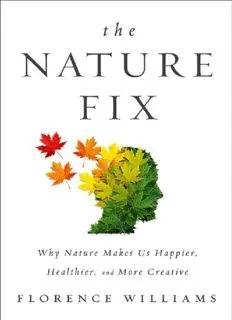
The Nature Fix: Why Nature Makes us Happier, Healthier and More Creative PDF
Preview The Nature Fix: Why Nature Makes us Happier, Healthier and More Creative
To my father, John Skelton Williams, for showing me the natural world in the first place. You always made it magical. CONTENTS Introduction: The Cordial Air PART ONE LOOKING FOR NATURE NEURONS The Biophilia Effect 1. How Many Neuroscientists Does It Take to Find a Stinking 2. Milkvetch? PART TWO NEARBY NATURE: THE FIRST FIVE MINUTES The Smell of Survival 3. Birdbrain 4. Box of Rain 5. PART THREE FIVE HOURS A MONTH You May Squat Down and Feel a Plant 6. Garden of Hedon 7. Rambling On 8. PART FOUR BACKCOUNTRY BRAIN Get Over Yourself: Wilderness, Creativity and the Power of Awe 9. Water on the Brain 10. Please Pass the Hacksaw 11. PART FIVE THE CITY IN A GARDEN Nature for the Rest of Us 12. Epilogue Acknowledgments Notes Illustration Credits THE Nature Fix INTRODUCTION The Cordial Air May your trails be crooked, winding, lonesome, dangerous, leading to the most amazing view. —EDWARD ABBEY I was hiking in Arches National Park when the Mappiness app in my phone pinged me. Some people would be annoyed, but not I. Finally, I was somewhere outside and beautiful and could tell the app how happy, relaxed and alert I was. Very, very and very. I told it so by tapping on the screen. Then I victoriously took a photo of the smooth, salmon-colored cliffs in front of me. Small topographies of lichen poked through a crack. A few perfect white clouds pottered across a French blue sky. Let Big Brother, toiling away in some windowless university lab, eat that for lunch. After many months and 234 interactions with this app, I almost always got pinged when I was indoors and working, which didn’t seem very helpful to either the Mappiness project or to my own. (And it didn’t seem fair, because I was outside fairly often, wasn’t I?) Mappiness is in the midst of a multiyear big-data grab, asking tens of thousands of volunteers to record their moods and activities twice a day at random times. Then it matches those responses to an exact GPS location from which it extracts information on the weather, amount of daylight and other environmental characteristics. The aim is simple: What makes people happy? Does place matter, or not so much? Big Brother—or Big Scientist, really—is George MacKerron, a young and congenial economist at the University of Sussex. As he explained it to me, much of the happiness data out there involves relationships, activities and economic behaviors, and much of it is familiar: people are happiest when they are well enmeshed in community and friendships, have their basic survival needs met, and keep their minds stimulated and engaged, often in the service of some sort of cause larger than themselves. But MacKerron wondered about the people who already have these things going for them, or, for that matter, about the people who don’t; are there other factors that could make meaningful differences in the march of their days? To find out, he launched Mappiness in 2010 and within a year had gathered 20,000 participants and over a million data points (by the time I joined a few years later, he was up to 3 million). Here’s what the data shows: People are least happy at work or while sick in bed, and most happy when they’re with friends or lovers. Their moods often reflect the weather (most live in the UK, so that’s not surprising). But one of the biggest variables, the surprising one, is not who you’re with or what you’re doing (at least for this iPhone-using crowd, which tends to be young, employed and educated). It’s where you are. As one of MacKerron’s papers concludes: “On average, study participants are significantly and substantially happier outdoors in all green or natural habitat types than they are in urban environments.” (And, in case you’re wondering, the data didn’t just reflect a vacation effect, since he factored that in.) The difference in joy respondents felt in urban versus natural settings (especially coastal environments) was greater than the difference they experienced from being alone versus being with friends, and about the same as doing favored activities like singing and sports versus not doing those things. Yet, remarkably, the respondents, like me, were rarely caught outside. Ninety-three percent of the time, they were either indoors or in vehicles. And even the app’s definition of “outside” could mean standing at an intersection or collecting the mail. My own personal data was pretty pathetic. The app caught me exercising or relaxing outside only 17 times, or 7 percent of the pings over the course of a year. Most often I was working, followed by number two, doing childcare, followed by commuting, doing housework and eating (well, at least something was fun). In the midst of a flirtation with meditating, I was caught doing that exactly twice. What Mappiness reveals—our epidemic dislocation from the outdoors—is an indictment not only of the structures and habits of modern society, but of our self-understanding. As the writer Annie Dillard once said, how we spend our days is how we spend our lives. Why don’t we do more of what makes our brains happy? Are we just too knackered by life’s demands, too far away from greenery or too tempted by indoor delights, especially the ones that plug in? Partly, but not entirely. In a revealing set of studies at Trent University in Ontario, psychologist Elizabeth Nisbet sent 150 students either outside to walk on a nearby path along a canal, or underground to walk through the well-used tunnels connecting buildings on campus.
